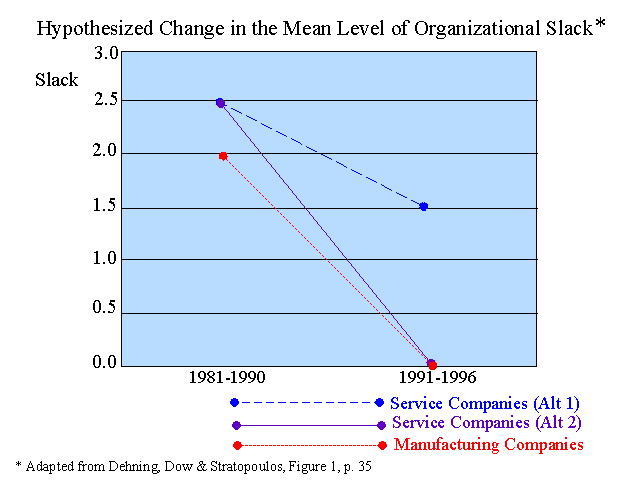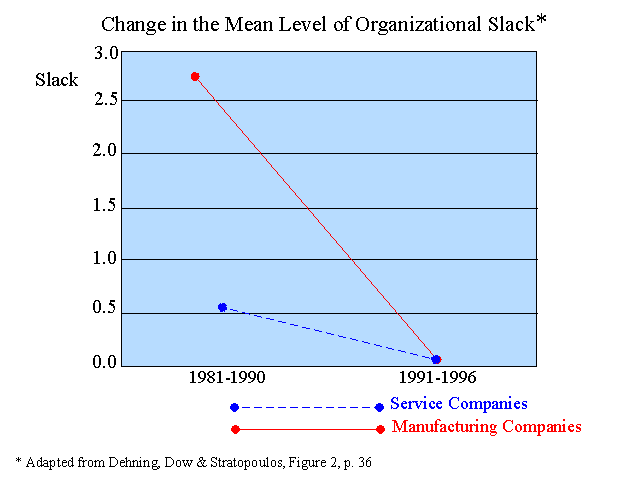
Summary by Christin Howells
Master of Accountancy Program
University of South Florida, Fall 2004
Productivity Main Page | Technology
Related Main Page | Investment Management Main Page
The purpose of this paper is to examine the effect of increased information technology on productivity and organizational slack. The productivity paradox refers to the fact that prior to the 1990s, companies made significant investments and improvements in technology with little improvement in productivity. The first study of this paradox was completed in 1988 and the results supported the view that there was no correlation between investments in IT and profitability.
Prior Empirical Research
The following explanations have been explored in an effort to explain why increased IT has not resulted in increased productivity or performance.
“Mismanagement of information and technology and redistribution and dissipation of profits.” This has been interpreted to suggest that if the implementation of new IT is not accompanied by new, improved business processes, the desired increase in productivity may not be achieved. It also suggests that the management of IT projects is very difficult and that significant problems can be encountered during its implementation. Though the theories of mismanagement and redistribution have been proven as an explanation for the paradox, the theories of increased slack in relation to mismanagement have not yet been tested.
The second explanation is that time is needed for employees to adapt to the new technology. This has been supported by several studies that indicate that it may take several years before the results of the new technology are seen in productivity and financial measures, concluding that such investments will pay off. As a result is has been suggested that an adjustment time be allowed prior to the measurement of the effects of such IT implementations.
Several other theories have been suggested including the idea that short life spans of many IT investments makes it difficult to observe their impact on financial performance. Also, researchers may not have properly identified or measured any gain in productivity as a result of the IT improvements. Finally, a large portion of the IT investments made have been in the service industry where productivity improvements are difficult to measure.
Another measure used in determining the effectiveness of increased information technology is organizational slack. Organizational slack is “the excess of what is required for normal operation of the organization”. Dehning, Dow, and Stratopoulos suggest that organizational slack can have both negative and positive effects on innovation. A negative effect on innovation may result when there is too much slack, but a positive effect on innovation may result where the proper amount of slack is involved.
Hypotheses and Theory
Researchers agree that the productivity paradox took place from 1981-1990, stating as evidence that there were no market reactions to “IT investment announcements”. However, this was not the case from 1991-1996, indicating the end of the productivity paradox. As such, the authors developed two hypotheses in relation to the change in organizational slack as a result of IT implementations.
“There will be an increase in slack for firms that implemented IT during the productivity paradox era but not after.”
“The increase in slack for service firms from IT implementation is more than that for manufacturing firms.”
Methodology
Slack was measured as the sum of:
Accounts receivable as a percentage of sales
+ Inventory as a percentage of sales
+ Selling, general & administrative expenses as a percentage of sales.
The change in slack was measured as the difference between the average slack before the IT investment and the average slack five years after the IT investment. Their hypothesized expectations are illustrated in the graphic below.

Regression analysis was used to test the two hypotheses. The equation used is as follows:
Change in Slack = b0 + b1Size + b2ABROE + b3Time + b4Industry + b5Time x Industry + e
Where:
Size = firm size measured as the natural log of sales.
ABROE = Abnormal return on equity measured as ROE minus the industry median ROE
Time = A dummy variable that was 0 for 1981-1990 and 1 for 1991-1996.
Industry = A dummy variable that was 1 for service and 0 for manufacturing.
Time x Industry = Interaction between TIME and Service dummy variables.
The results (provided in Tables 1 and 2 in the paper on pp. 35 and 36) indicated that there was an increase in the average level of slack for both manufacturing firms and service companies from 1981-1990. The mean slack increased by 2.8 for manufacturing firms and .55 for service firms, though statistically insignificant. For the time period 1991-1996, manufacturing firms experienced a .05 increase, while service firms saw a .09 increase. These results support the authors’ first hypothesis while indicating the opposite for their second hypothesis, i.e., that manufacturing firms experienced more of an increase in slack than service companies. These results are illustrated in the graphic below.

Conclusion
Research has indicated that the productivity paradox did exist, but “disappeared in 1991”. Research has also shown that investments in IT can “improve performance” although the effects of IT investments may appear as increased productivity, increased organizational slack, or improved financial performance. It seems clear from this study and other research studies that the full benefits from IT investments are only obtained when IT investments are adequately implemented and integrated into the organizations overall system.
________________________________________
Related summaries:
Bensaou, M. and M. Earl. 1998. The right mind-set for managing information technology. Harvard Business Review (September-October): 119-128. (Summary).
Clyman, J. 2004. Business IT: Rent or buy? Many companies are outsourcing IT duties to third parties and reaping benefits. PC Magazine (October 19): 129-132, 134, 136, 138. (Note).
Colvin, G. 2015. Humans are underrated. Fortune (August): 100-113. (Summary).
Davenport, T. H. 1998. Putting the enterprise into the enterprise system. Harvard Business Review (July-August): 121-131. (Summary).
Elliott, R. K. 1992. The third wave breaks on the shores of accounting. Accounting Horizons 6 (June): 61-85. (Summary).
Hammer, M. 1990. Reengineering work: Don't automate, obliterate. Harvard Business Review (July-August): 104-112. (Summary).
Hammer, M. 2001. The superefficient company. Harvard Business Review (September): 82-91. (Summary).
Hammer, M. 2007. The process audit. Harvard Business Review (April): 111-123. (Note).
Hayzen, A. J. and J. M. Reeve. 2000. Examining the relationships in productivity accounting. Management Accounting Quarterly (Summer): 32-39. (Summary).
Martinsons, M., R. Davison and D. Tse. 1999. The balanced scorecard: A foundation for the strategic management of information systems. Decision Support Systems (25): 71-88. (Summary).
Williams, S. 2011. 5 Barriers to BI success and how to overcome them. Strategic Finance (July): 26-33. (Note).